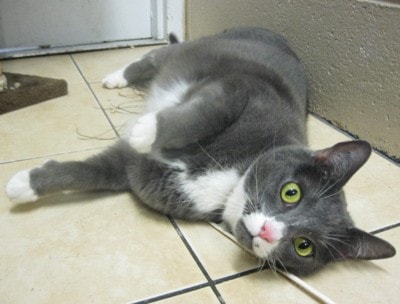Wanted: home for holidays
The holidays may be a tougher time for pet owners than for our furry, finned or feathered friends, but now is the purrfect time to consider those who are waiting to play under the mistletoe.
The Victoria Pet Adoption Society has partnered with a national organization this season in hopes that people will remember the hundreds of animals who are still waiting for homes — or are at risk of losing the ones they have.
“I don’t believe the holidays are a particularly tough time for missing/stray animals — Halloween is bad because a lot of pets get scared by fireworks. The bigger issue is animals being surrendered because their families can’t afford medical care,” says Catherine Clayton, coordinator of the society. “For example, a kitten eats a string, or piece of tinsel, and it needs medical care. Its family takes it to the vet but can’t afford to provide that care because they’ve just spent a fortune on Christmas gifts or on a family vacation.”
The story is all too common for shelters around Victoria that also report a large number of surrenders in January and February, when people who have received pets as holiday gifts give them up due to lack of interest or inability to provide for them.
Cue the “Iams Home 4 the Holidays” pet adoption drive, which is supporting 4,000 shelters and animal rescue centres around North America from Oct. 1 through Jan. 2, in a dedicated effort to finding loving homes for orphaned pets. The Victoria Pet Adoption Society is one such benefactor, and will receive international media attention, opportunities to engage with potential adopters and volunteers and free food for the animals. Pet owners can help through the “Bags 4 Bowls” campaign, where Iams will donate one bowl of food to the participating organizations for every specially marked package of Iams pet food purchased during the campaign.
“With as many as 36 per cent of animals euthanized every year in Canadian shelters, this campaign is a wonderful platform to raise awareness about pet adoption and homelessness,” says Barbara Cartwright, CEO of the Canadian Federation of Humane Societies. “This year, we hope to debunk the myths that surround shelter animals and place deserving pets into the homes of loving families.”
For those who want to ensure their assistance stays local, there are many ways to help the society and those four-legged friends all year round: become a pet foster home, volunteer with the society or at a partnering shelter, sponsor a pet’s care directly, make the Victoria Pet Adoption Society a benefactor in your will, or fill some of the “Wish List” items needed at VictoriaPets.ca.
“One of the most wide-spread myths about animals in shelters is that they are ‘damaged goods,’” says Clayton. “The most common reasons for animals being surrendered to Victoria Pet Adoption Society are: owners moving into homes that do not allow pets, family break-ups, pet-related allergies and owners passing away and leaving their pets orphaned.”
Another misconception Clayton cautions against is the belief that adoption fees for animals are high. Although fees can reach into the hundreds of dollars, reputable adoption agencies will ensure each animal is healthy, vaccinated, spayed/neutered (or will offer a voucher toward the surgery) and that the animal has been assessed behaviourally.
“If a person were to receive a free pet and took him/her to the veterinarian to have the spay/neuter, vaccines and health check done, it would cost more than the adoption fee,” Clayton says “The fees are almost always considerably less than the value of what the adopter is receiving.”
Getting to Zero by 2015— By Colin Cayer
Approximately 6,380 Aboriginal people are currently living with HIV. Accounting for only four per cent of Canadians, Aboriginal people are over-represented at 12 per cent of all new HIV infections. And, without a change to systemic political barriers and improved education and outreach services, advocacy groups say the numbers will only rise.
Aboriginal AIDS Awareness Week began this past Sat., Dec. 1 and AIDS Service Organizations throughout Victoria have come together to make that change. With the lofty goal of reaching zero new HIV infections by 2015, cities across Canada are hosting events to raise awareness.
On Dec. 5 and 6 Victoria’s Red Road/AIDS Network presents “Celebrating Aboriginal Women.” Speakers include Deputy of Provincial Health Officer Dr. Evan Adams, Policy Director of BC Civil Liberties Association Micheal Vonn and Native Youth Sexual Health Executive Director Jessica Danforth, among others. The event will be held at the Hotel Grand Pacific in the Vancouver Island Ball Room (463 Belleville) from 9am-4pm. M
